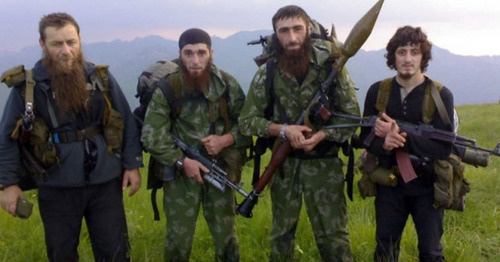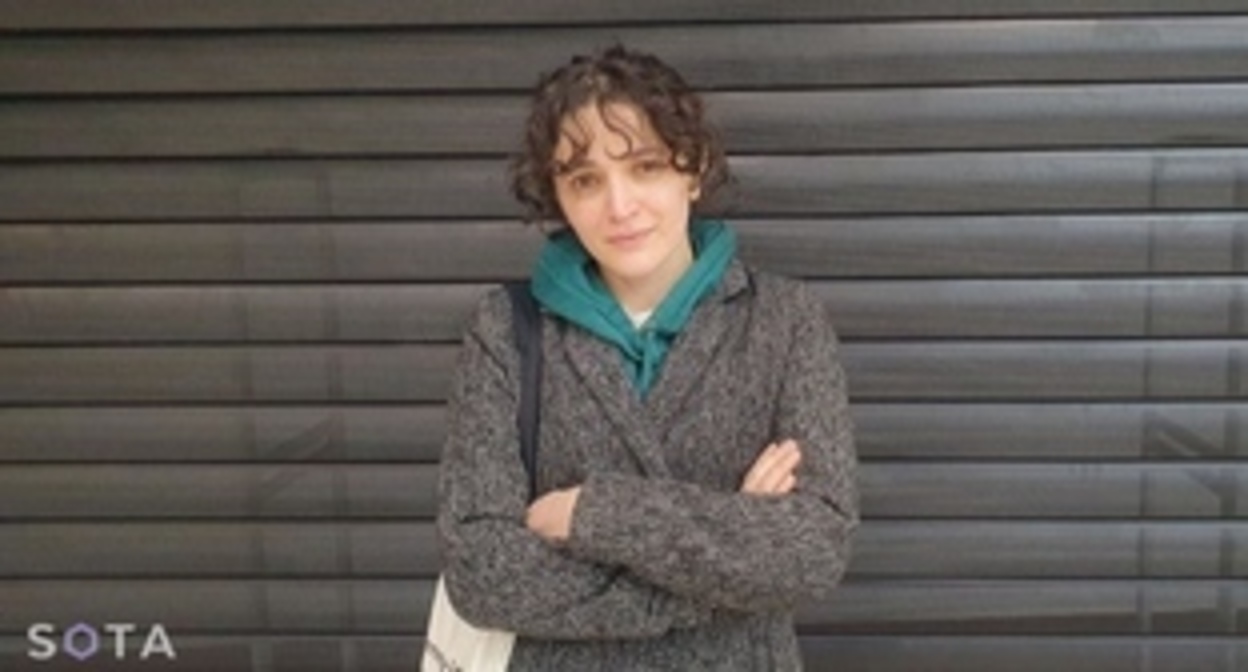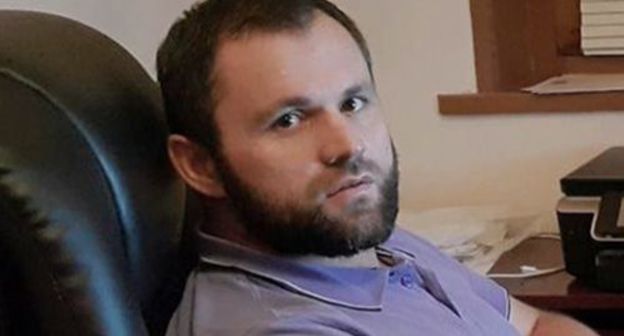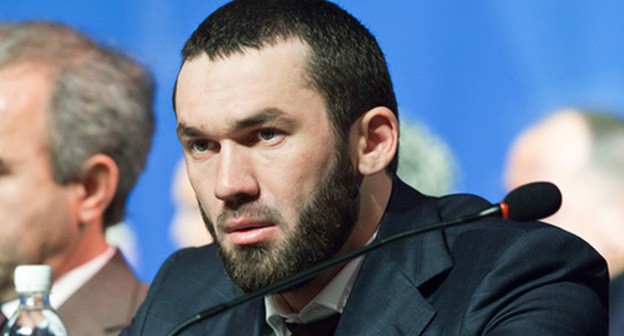Caucasians in the ranks of IS (ISIL)
Different sources, including the Russia's FSB, have confirmed the information that militants from Russia are fighting for the Islamic State (IS) (earlier – the Islamic State of Iraq and the Levant – ISIL), a self-proclaimed entity in the territory of Syria and Iraq. The material of the "Caucasian Knot" below tells about penetration of natives of the Caucasus into the conflict zone and provides estimates of the number of them.
"Islamic State": overview
The organization "Islamic State" was created on October 15, 2006, as a result of the merger of 11 radical Sunni groupings. At the same time, they adopted a draft "Constitution" entitled "Notice to Mankind about Birth of Islamic State". Until 2013, its name was "Islamic State of Iraq" (ISI). The organization set a target to capture the Sunni part of Iraq and turn it into a militarized Islamic Sunni state, as soon as the forces of the international coalition led by the USA, left Iraq.
On April 9, 2013, the grouping named "Islamic State of Iraq and the Levant" (ISIL) was formed with the aim to establish an Islamic Emirate in the territory of Lebanon, Syria and Iraq. The Levant is a historical region in the eastern Mediterranean, which covers the territory of Syria, Lebanon, Israel, Jordan, Palestine, Egypt, Turkey and Cyprus.
Starting June 2014, ISIL launched an attack on several areas of Northern Iraq by organizing a large-scale offensive in Sunni provinces. By October 2014, ISIL occupied one-third of Iraq.
The terrorist organization is made up of the militants who once fought against US forces during their stay in Iraq, and against the forces of the government of Bashar al-Assad in Syria.
By September 2014, according to the estimates of the CIA (US Central Intelligence Agency), the membership of the grouping reached some 20,000-31,500 persons. The IS troops include Mujahideens from 80 countries, including France, UK, Germany, Morocco, Saudi Arabia, USA, Canada and Russia.
Since the moment of its inception, ISIL has been closely connected with the international terrorist network "Al-Qaeda", but in February 2014 the latter declared a break-off with the "Islamic State". The reason for the split was in the quarrel of the ISIL with the official branch of "Al-Qaeda" in Syria named "Djabkhat an-Nusra".
In late June 2014, the grouping changed its name and became known as just the "Islamic State". The establishment of Caliphate was proclaimed led by militants' leader Abu Bakr al-Baghdadi (Abdullah Ibragim as-Samarai).
The "Islamic State" has been recognized as a terrorist organization by Australia, UK, Indonesia, Canada, Saudi Arabia, USA, Turkey and other countries.
On September 8, 2014, the grouping "Islamic State" was recognized as a terrorist organization by the League of Arab States. Besides, the "Islamic State" is subject to international sanctions in accordance with Resolutions of the UN Security Council passed against "Al-Qaeda" and its affiliated organizations.
Gennady Gatilov, a Russian Deputy Foreign Minister, in one of his speeches has treated the ISIL as an "extremist" organization involved in "terrorist activities".
On September 3, 2014, supporters of the "Islamic State of Iraq and the Levant" distributed the video record, in which they accused Russia of supplying weapons to Bashar al-Assad and threatened to start a war in the Caucasus.
Islamic State and natives of the Caucasus
How many natives of the Caucasus fight for "Islamic State"?
In June 2013, Russian authorities admitted the participation of citizens of the Russian Federation in the conflict. The Russia's FSB Director Alexander Bortnikov expressed concern about the fact that some 200 militants from Russia were fighting for jihadists in Syria. The Chechen leadership also admitted that residents of the republic were taking part in the war in Syria. It was reported that from a few hundreds up to 1700 natives of Chechnya were at war in the region.
In September 2013, it became known that militants from Northern Caucasus formed a military unit named "Al-Mukhadjirin" (immigrants) in the city of Aleppo in Northern Syria. It was headed by a Chechen named Abu Abdurakhman. Most members of the unit had experience of fighting in the Caucasus.
In July 2014, Sergey Kamenny, the head of the FSB in Kabardino-Balkaria, said that more than 60 citizens of his republic were among the international terrorist groupings operating in Syria.
On September 3, 2014, supporters of the "Islamic State of Iraq and the Levant" spread a video with a threat to start a war in the Caucasus and "liberate the Caucasus by the mercy of Allah."
According to Sergey Smirnov, First Deputy Director of the FSB, some 300-400 mercenaries from Russia, now involved in the Syrian conflict, may come back to Russia.
According to Abu Umar al-Shishani, a field commander of Chechen origin, "500 Caucasians, who had fought against Bashar al-Assad in Syria, were killed." The al-Shishani's grouping, which is at war under the banner of the ISIL, has between 700 and 1000 members; among them there are several hundreds of Caucasians.
It is noteworthy that the authors of the information-analytical bulletin prepared by the Human Rights Centre (HRC) "Memorial" report that the drop in the number of victims of the conflict in Northern Caucasus, noticed in 2014, was associated with the fact that part of radicals went to Syria.
How Caucasian natives get into ISIL?
According to Musa Muradov, an observer of the "Kommersant", the majority of Chechens involved in the armed conflict in Syria, had come there from Europe, after receiving their early indoctrination through the Internet. "Some of them arrive from Northern Caucasus via Turkey; and some of them come from Europe. These are people who were born in Western countries; and whose parents had long ago moved there as refugees."
As noted by Muradov, students of Islamic schools are less affected by Islamist rhetoric.
This idea is also strongly supported by the head of Chechnya Ramzan Kadyrov, who asserts that Chechens arrive to war in Syria and Iraq not only from the Chechen Republic, that is, from the territory of the Russian Federation, but also from the numerous Chechen Diaspora. His words were confirmed by detention in August 2014 in Austria of nine Chechens, who had refugee status and were about to go to war in the Middle East.
Besides, there were cases of departure to Syria of Chechen pilgrims, who were making their Hajj to Saudi Arabia. In particular, in November 2013, one of Chechen pilgrims fled to Syria. However, Chechen law enforcement bodies refused to comment on this information. "We occasionally receive information that young people leave Chechnya for Syria; however, these messages need careful examination and clarification, since the data can be quite controversial," a source from the Chechen Ministry of Internal Affairs (MIA) told the "Caucasian Knot" correspondent.
Meanwhile, the recruitment of mercenaries was held not only in Northern Caucasus, but also in Russia's neighbouring states. In particular, in late September 2014 the Ministry of National Security (MNS) of Azerbaijan conducted an antiterrorist operation. MNS employees detained 26 citizens of the country, who fought at various times in the ranks of the ISIL and other terrorist groupings.
Abu Umar al-Shishani
Since May 2013, the military command of Islamists of the ISIL fighting in Syria is entrusted to Abu Umar al-Shishani (his real name is Tarkhan Batirashvili), a native of Pankisi Gorge. Abu Umar al-Shishani had served in the Georgian Army, from where he was dismissed for health reasons. Since 2013, he became involved in the warfare in Syria and Iraq.
In Syria Abu Umar al-Shishani headed the Islamist grouping "Jaish al-Mukhajirin wal-Ansar" (Army of Muhajirs and Guerrilla Fighters). According to the Internet sources close to the North-Caucasian underground, the grouping includes militants who came from Russia, Ukraine and other CIS countries.
Until the end of 2013, the "Jaish al-Mukhadjirin wal-Ansar" actually identified as the ISIL. However, in late November 2013, a split took place. Abu Umar al-Shishani and his supporters began identifying themselves with the ISIL, while some Islamist groups continued operating independently under a new commander - Salakh ad-Din al-Shishani (in both cases "al-Shishani" is translated from the Arabian language as "a Chechen").
On September 24, 2014, media spread information that Abu Umar al-Shishani announced a reward for liquidation of the head of Chechnya Ramzan Kadyrov and his retinue.
Abu Umar al-Shishani has been put on the US "black list" on suspicion of aiding and abetting terrorism.
On November 13, 2014, Ramzan Kadyrov in his Instagram (kadyrov_95) reported the death of Umar al-Shishani. As calculated by the "Caucasian Knot", the information of the Chechen leader Ramzan Kadyrov about the death of Tarkhan Batirashvili, became the fifth message from different sources about the murder of one of the leaders of the "Islamic State" since February 2013. However, a source from the Pankisi Gorge in Georgia refuted the death of al-Shishani to the "Caucasian Knot" correspondent.
Participation of natives of Caucasus in warfare in Syria and Iraq
In January 2014, reports appeared about clashes of various Sunni Islamist groupings. The edition named "Arguments of the Week" quoted "one of the militants from the Caucasus", who said that during one of shootouts militants of the ISIL, including natives of CIS countries and regions of Russia, were killed.
As reported by the Voice of America, in February 2013, about two dozens jihadists from Northern Caucasus were killed near Aleppo. According to the Syrian opposition, Chechen fighters were the second largest foreign grouping that fought against the Assad regime.
According to Walid Muallem, the head of the Ministry of Foreign Affairs (MFA) of Syria, mercenaries from Northern Caucasus were recruited by the radical Islamist grouping "Djabkhat an-Nusra" (Support Front of Syrian People).
In summer of 2014, ISIL militants took control over the territory of Northern Iraq and the city of Mosul – a place of compact residence of Yezidi Kurds. ISIL militants were involved, in particular, in abduction of Kurdish women. The edition named "Daily Beast" quoted the words of Pakshan Zangana, the head of the Supreme Council for Women's Matters of the Kurdish Regional Government. According to her story, Chechens, who were identified by their Russian language and ginger beards, were involved, among other militants, in the abduction and rapes of Kurdish women.
According to members of the Chechen Diaspora in Western Europe, hundreds of Chechen militants are fighting in the ranks of the Syrian opposition: they are called to join the Syrian opposition by supporters of the terrorist organization "Islamic State Imarat Kavkaz", which is banned in Russia.
In 2013, a son of the Chechen field commander Ruslan Gelaev was killed in Syria. According to the version, disseminated by militants' Internet websites, he died while fighting for the opposition. However, his relatives argued that Gelaev junior was in Syria for training and was killed in the mosque, which was shelled by the governmental aviation.
The statement released by the Russia's MFA in July 2013 said that one of the Islamist groupings fighting against Bashar al-Assad was headed by a native of Chechnya, a certain Abu-Musaab.
Suleiman Zailanabidov
On November 21, 2014, a video was posted on the Internet "YouTube" service, in which Suleiman Zailanabidov, one of the commanders of Aukh militants, acting in the Khasavyurt District of Dagestan, after being blamed by his supporters for splitting, sworn to Abu Bakr al-Baghdadi, the leader of the "Islamic State". The map, implanted into the video prior to Zailanabidov's statement, did not depict the Aukh District as a part of the Vilayat Dagestan of the "Imarat Kavkaz".
A month before that, as reported by the "Caucasian Knot", the leader of the underground of Khasavyurt announced Zailanabidov as wanted in the territory of Dagestan and Chechnya. The video that was posted on the YouTube on October 15 showed the commander of Khasavyurt militants accuses Zailanabidov of self-appointing himself to be Amir of Aukh militants, introducing "confusion" into the ranks of the underground, and did not obey his superiors, by ignoring their council (shura).
On October 21, 2014, some media reported with reference to the press service of the Kazakh National Security Committee (NSC) that a native of Chechnya, who was on the Russia's federal wanted list under the name of Suleiman Zailanabidov was detained in Almaty Airport upon arrival from Ukraine. Also, the report contained information that the extradition procedure to the Russian Federation was initiated in relation to Zailanabidov. Later, however, the NSC of Kazakhstan refuted the information about Zailanabidov's detention.






![Tumso Abdurakhmanov. Screenshot from video posted by Abu-Saddam Shishani [LIVE] http://www.youtube.com/watch?v=mIR3s7AB0Uw Tumso Abdurakhmanov. Screenshot from video posted by Abu-Saddam Shishani [LIVE] http://www.youtube.com/watch?v=mIR3s7AB0Uw](/system/uploads/article_image/image/0001/18460/main_image_Tumso.jpg)